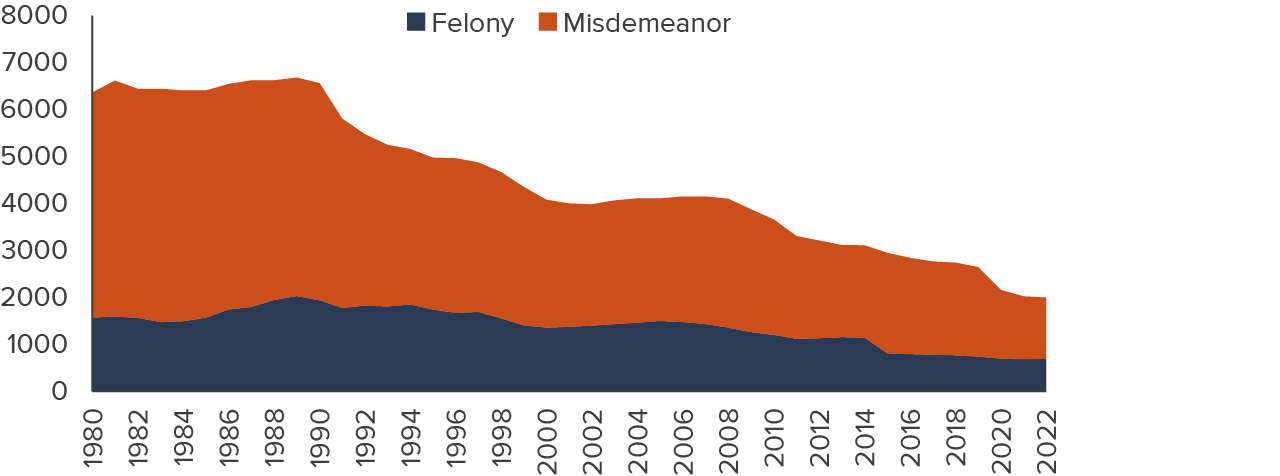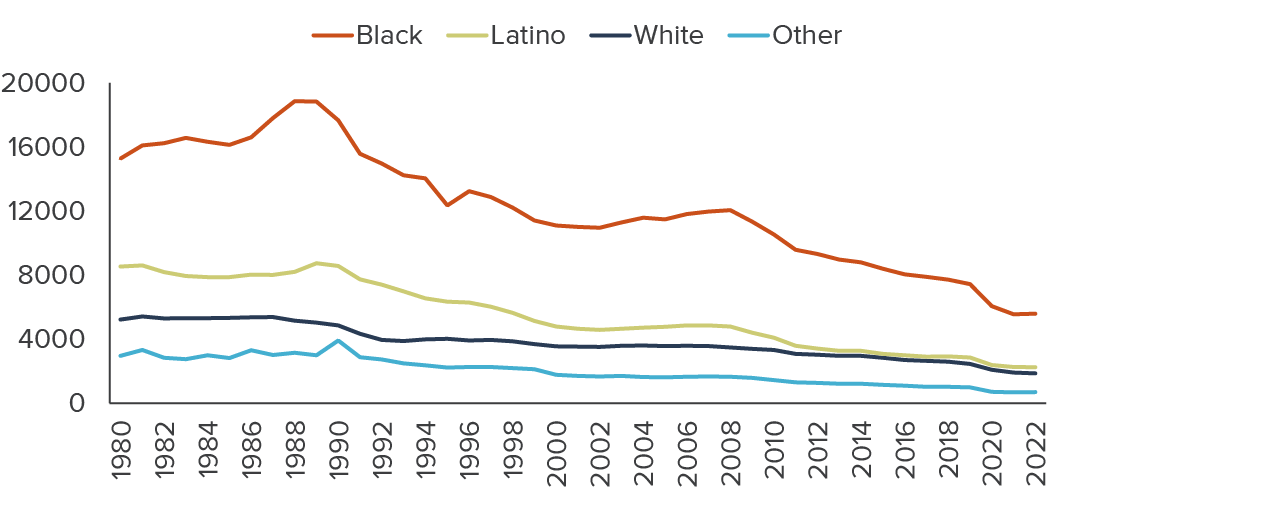California’s overall arrest rate was historically low in 2022.
- Law enforcement agencies in California reported roughly 781,000 arrests in 2022; this translates to a historically low rate of 2,001 arrests per 100,000 residents. The overall arrest rate declined by 1% from 2021 to 2022, after dropping by 6.5% from 2020 to 2021.
- Law enforcement policies and reduced public mobility during the pandemic may have contributed to a notable 31.2% drop in misdemeanor arrests since 2019; felony arrests declined by 6.9% during that period.
- Arrest rates have been falling over the past few decades: after peaking in 1989 at 6,757 arrests per 100,000 residents (with nearly 2 million arrests reported), the overall arrest rate declined sharply throughout the 1990s.
- The steady decline since 2006 has been driven by a drop in arrests for misdemeanors (offenses with a maximum sentence of one year in jail) and fewer arrests of juveniles and young adults.
Arrest rates have declined steadily since the early 1990s and were at historic lows in 2022
Arrest rate

SOURCE: Authors’ calculation based on California Department of Justice’s Open Justice Arrests dataset and California Department of Finance Population Data, 1980–2022.
NOTE: Arrest rates are the number of arrests per 100,000 residents, not age adjusted.
Arrest rates for felonies rose slightly in 2022.
- Roughly 268,200 felony arrests were made in 2022. For the first time since 2013, the arrest rate for felonies (offenses with maximum sentences of more than one year in jail or prison) rose (by 1%) from 2021 to 2022.
- Violent offenses made up a larger share of felony arrests in 2022 (36.6%) than in 2021 (35.1%) while drug offenses made up a smaller share of felony arrests in 2022 (7.7%) than in 2021 (8.9%).
- Weapons-related offenses accounted for 9.7% of felony arrests in 2022, down from 10% in 2021.
Drug offenses are the largest category of misdemeanor arrests.
- About 511,600 misdemeanor arrests were made in 2022. About one in four (25.4%) of these arrests were for drug offenses; 19.6% were for driving under the influence, and 14.1% were for battery/assault.
- Public intoxication accounted for 6.7% of misdemeanor arrests, and offenses related to petty theft accounted for 3.3%.
Racial disparities in arrest rates have lessened over time but remain significant.
- The rise and fall of arrest rates over the past several decades has been especially marked among Black Californians. The Black arrest rate peaked in 1988 at 18,856 per 100,000 residents. By 2022, it had dropped by 13,260 (or 70%), to 5,596 per 100,000 residents.
- Among the 15 largest counties in the state, the largest Black/white arrest disparity in 2022 was in San Mateo, where the Black arrest rate was 9.1 times higher than the white arrest rate. Kern County had the lowest Black/white arrest disparity (2.4).
- In 2022, the Latino arrest rate was 2,246 per 100,000 residents, and the white arrest rate was 1,862. Since 1988, these rates have declined 73% (by 5,958 per 100,000) and 64% (by 3,284 per 100,000).
Racial disparities in arrests were less extreme but still significant in 2022
Arrest rate

SOURCE: Authors’ calculation based on California Department of Justice’s Open Justice Arrests dataset and California Department of Finance Population Data, 1980–2022.
NOTE: Arrest rates are the number of arrests per 100,000 residents, not age adjusted.
Men are arrested at a substantially higher rate than women, but the gap has narrowed.
- The male arrest rate in 2022 was 3,128 per 100,000 residents—more than three times the female arrest rate of 886.
- The gender gap has narrowed notably over time. In 1980, the male arrest rate was more than six times the female rate (11,258 and 1,850, respectively). Since then, the female share has grown from 14.5% to 22.3%.
- This narrowing has been driven largely by a drop in male misdemeanor arrests from 8,336 per 100,000 residents in 1980 to 2,015 in 2022.
- While the male violent arrest rate declined from 659 per 100,000 residents in 1980 to 391 in 2022, the female violent arrest rate rose from 72 in 1980 to 113 in 2022.
Arrest rates vary widely across counties.
- Many factors, including crime rates, economic and demographic characteristics, and law enforcement policies, could be driving variation in arrest rates across the state.
- Rural counties in 2022 had an arrest rate of 3,026 per 100,000 residents, while urban counties had an arrest rate of 1,978 per 100,000.
- Sutter (5,418), Shasta (5,116), Del Norte (5,048), and Siskiyou (4,942) had the highest arrest rates in the state. Rates in these counties were more than three times higher than the lowest rates in San Francisco (1,364), Glenn (1,453), and Nevada (1,520).
Topics
Criminal Justice




